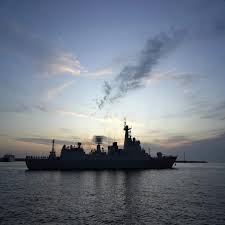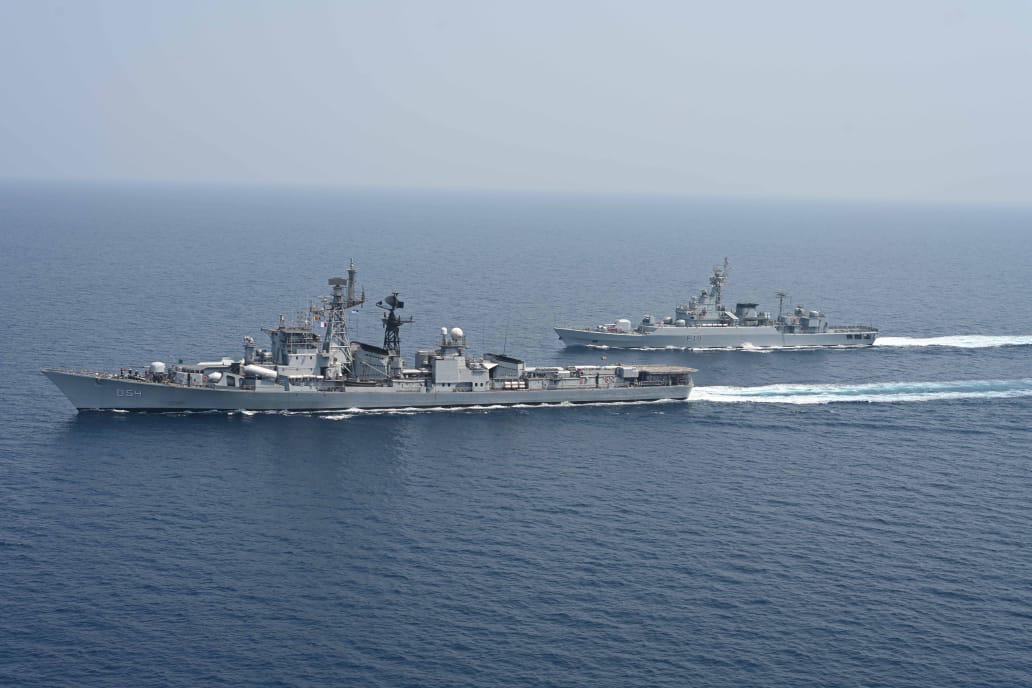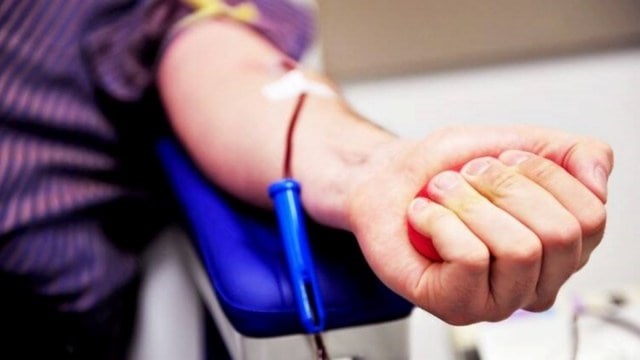Maritime Security Belt 2025

- 16 Mar 2025
In News:
Amid rising tensions over Iran’s expanding nuclear program and threats from Yemen's Houthi rebels, China, Iran, and Russia conducted the Maritime Security Belt 2025 naval exercise in the Gulf of Oman, strategically located near the Strait of Hormuz. This region is of global significance as it serves as a major maritime route, through which a fifth of the world’s crude oil is transported daily.
Key Highlights of the Exercise
- Location: Gulf of Oman, near the Strait of Hormuz, connecting the Persian Gulf to the open seas. This waterway is crucial for global energy supplies and trade.
- Participating Navies:
- Iran: State-run media highlighted the drills as a show of strength, particularly after Israeli strikes targeted Iran’s defense and missile programs.
- Russia: Participated with corvettes Rezky and Aldar Tsydenzhapov as well as the tanker Pechenega. Russia continues to rely on Iran for drone supplies, particularly in the ongoing war in Ukraine.
- China: Sent guided-missile destroyer Baotou and supply ship Gaoyouhu. China maintains deep ties with Iran, especially in the oil sector, despite facing Western sanctions.
- Operational Objectives:
- The exercise aimed to enhance coordination and operational synergy between the three nations, with a focus on maritime security, countering threats to shipping lanes, and addressing global security challenges.
- It featured live-fire drills, night operations, and complex naval maneuvers, ensuring the readiness of all three navies to respond to maritime threats.
- Regional Significance: The Gulf of Oman serves as the only maritime access for Iran to the open seas, making it critical for global trade. The Strait of Hormuz is particularly significant as it handles a significant portion of the world’s oil trade.
Strategic Context and Implications
- Nuclear Tensions: Iran's nuclear program, which has drawn concerns from both Israel and the U.S., remains a central issue in the region. The exercises coincide with the growing concerns over Iran’s stockpiling of uranium enriched to near weapons-grade levels, despite Tehran's assertions that its nuclear ambitions are peaceful.
- Impact of Drills: These joint naval exercises highlight the growing influence of China and Russia in the Middle East, both of which have strategic ties with Iran. While these countries do not patrol the wider Middle East region, their naval presence in the Gulf signals their deepening involvement in the region’s security dynamics, particularly in opposition to the U.S.-led presence.
- Yemen's Role: The Houthi rebels in Yemen have previously targeted international shipping in the Red Sea and Bab el-Mandeb Strait, and have threatened to resume attacks unless humanitarian aid is allowed into Gaza. The instability in the region further complicates security, as seen in the potential for maritime disruptions.
Geopolitical Dimensions
- China’s Interests: China, as a major consumer of Iranian crude oil, continues to engage with Iran despite facing Western sanctions. These drills serve as a symbol of China’s increasing military presence and its growing role in the Middle East, particularly in energy security.
- Russia’s Involvement: Russia's reliance on Iran for bomb-carrying drones in the Ukraine conflict further deepens the military relationship between the two nations. The maritime drills highlight Russia’s interest in securing its position in the Middle East amidst growing tensions with the West.
- U.S. Interests: The U.S., which monitors the region through its 5th Fleet based in Bahrain, remains cautious of the growing military cooperation between China, Russia, and Iran. The drills, especially the interference with GPS systems, have raised concerns about regional stability and the ability to ensure free navigation through critical maritime chokepoints.
Bongosagar 2025 Naval Exercise

- 16 Mar 2025
In News:
India and Bangladesh conducted the Bongosagar 2025 naval exercise in the Bay of Bengal, aimed at enhancing maritime cooperation, operational interoperability, and regional security. This joint exercise aligns with India's maritime foreign policy doctrine — SAGAR (Security and Growth for All in the Region).
Key Highlights
- Participants:
- Indian Navy: INS Ranvir, a Rajput-class guided missile destroyer, commissioned in 1986.
- Bangladesh Navy: BNS Abu Ubaidah.
- Objectives:
- Strengthen tactical planning, information sharing, and coordinated response capabilities.
- Enhance interoperability for seamless maritime operations.
- Reinforce regional trust and cooperation under the SAGAR framework.
- Exercise Components:
- Surface firing drills
- Tactical manoeuvres
- Underway replenishment
- VBSS (Visit, Board, Search and Seizure) operations
- Cross-deck boarding exercises
- Communication drills
- Professional knowledge quizzes and steam past ceremonies
Strategic Significance
- Supports India’s SAGAR initiative (2015), promoting security and growth in the Indian Ocean region.
- Aligns with the broader MAHASAGAR (2025) vision — Mutual and Holistic Advancement for Security and Growth Across Regions — targeting deeper engagement with the Global South.
- Enhances the ability of both navies to counter maritime threats, uphold freedom of navigation, and ensure regional maritime stability.
India-Bangladesh Defence Cooperation
- Army-level: Exercise Sampriti
- Navy-level: Exercises Bongosagar and Coordinated Patrol (CORPAT)
India’s Carbon Credit Trading Scheme (CCTS)
- 16 Mar 2025
In News:
To meet its climate commitments under the Paris Agreement, India is moving towards a market-based mechanism for emissions reduction through the Carbon Credit Trading Scheme (CCTS), 2023. The scheme was made possible by amending the Energy Conservation Act, 2021 and replaces the Perform, Achieve, and Trade (PAT) scheme operational since 2012.
What is the Carbon Credit Trading Scheme (CCTS)?
- CCTS is India’s version of an emissions trading system (ETS) designed to reduce greenhouse gas (GHG) emissions intensity — emissions per unit of output — rather than absolute emissions.
- It introduces Carbon Credit Certificates (CCC), each representing one tonne of CO? equivalent (tCO?e) reduction.
- Managed by the Bureau of Energy Efficiency (BEE) and coordinated by a National Steering Committee, the scheme involves various regulatory bodies including electricity exchanges, MoEFCC, and the Central Electricity Regulatory Commission.
Key Features of the CCTS
Aspect Description
Transition from PAT - Shifts focus from energy efficiency (PAT) to emission intensity (CCTS).
Coverage - Initially targets energy-intensive sectors: Iron & Steel, Cement, Aluminium,
Fertilisers, Refineries, Pulp & Paper, and Textiles (~16% of national
GHG emissions). Power sector (~40%) may be included later.
Dual Mechanisms - 1. Compliance: Mandates targets for large emitters. 2. Offset:
Voluntary participants earn credits by reducing emissions.
Implementation Timeline - Expected to launch fully by mid-2026, in a phased manner.
Global Context of Carbon Pricing
- As of June 2024, 89 countries operate carbon pricing mechanisms, covering 12.8 Gt CO?e (25% of global emissions).
- Carbon pricing methods:
- ETS (Cap-and-Trade / Baseline-and-Credit): Companies trade allowances or credits based on performance.
- Carbon Tax: Fixed price on emissions; provides cost certainty but not emissions certainty.
- Crediting Mechanism: Projects generating verified emission reductions earn tradable carbon credits.
Challenges in Implementing CCTS
- Target Setting: Overly lenient targets may cause credit oversupply, reducing prices; overly strict ones risk high compliance costs.
- Compliance Gaps: Under PAT, over half the required energy certificates were never purchased, with no penalties imposed.
- Delays: Credit issuance under PAT (Phase IV onwards) has been delayed since 2021, affecting market confidence.
- Transparency: Lack of public access to data on actual performance undermines accountability.
- Monitoring and Verification (MRV): Requires robust systems to prevent double counting and ensure credible reporting.
Steps to Strengthen India’s Carbon Market
- Align with global practices: Learn from the EU ETS — implement strict monitoring, gradual tightening of caps, and price stability mechanisms.
- Robust MRV Framework: Ensure accuracy in emission data to boost trust.
- Digital Trading Platform: Track and authenticate credit transactions; avoid fraud.
- Industry Incentives: Encourage early compliance via tax benefits and access to green finance.
- Trade Compatibility: Prepare for global measures like the EU’s Carbon Border Adjustment Mechanism (CBAM) by ensuring transparency and comparability.
India’s CCTS represents a significant shift in climate governance by institutionalizing carbon pricing. While it brings India in line with evolving global practices, the success of the Indian carbon market will depend on credible enforcement, transparent functioning, and strong regulatory architecture. If implemented effectively, it can drive low-carbon growth and support India’s target of reducing emissions intensity by 45% by 2030.
India's Foreign Exchange Reserves witness sharpest rise in two years

- 16 Mar 2025
In News:
In a notable economic development, India’s foreign exchange (forex) reserves rose sharply by $15.267 billion to reach $653.966 billion during the week ending March 7, 2025. This marks the largest weekly increase in over two years, as per data released by the Reserve Bank of India (RBI).
Key Reason for the Surge
- The jump is attributed primarily to a $10 billion forex swap conducted by the RBI on February 28, 2025, where the central bank purchased US dollars in exchange for rupees.
- The objective was to inject liquidity into the domestic financial system while strengthening forex reserves.
Component-wise Breakdown
- Foreign Currency Assets (FCA): Increased by $13.993 billion to $557.282 billion.
(FCAs are held in major currencies like USD, Euro, Pound, Yen and are affected by their exchange rate fluctuations.) - Gold Reserves: Decreased by $1.053 billion to $74.325 billion.
- Special Drawing Rights (SDRs): Rose by $212 million to $18.21 billion.
- Reserve Tranche Position (RTP) with IMF: Declined by $69 million to $4.148 billion.
Understanding Forex Reserves
- Foreign Exchange Reserves are external assets held by a country's central bank, used to support its monetary and exchange rate policies.
- These reserves include:
- Foreign Currency Assets (FCA)
- Gold
- SDRs (with the International Monetary Fund)
- RTP (Reserve capital with the IMF)
Purpose and Importance
- Ensure external stability and maintain confidence in the currency.
- Help manage the exchange rate and balance of payments (BoP).
- Act as a buffer against external shocks, such as volatile capital flows or currency crises.
- Strengthen India’s international creditworthiness.
Global Context
- RBI is the custodian of India’s forex reserves.
- China holds the largest forex reserves globally.
India’s First CAR T-Cell Therapy

- 16 Mar 2025
In News:
India has achieved a significant milestone in cancer treatment with the successful clinical trials of its first CAR T-cell therapy, marking a crucial step in indigenous biomedical innovation. The findings were recently published in The Lancet, making it the first CAR T-cell clinical trial from India to appear in an international journal.
What is CAR T-Cell Therapy?
- CAR T-cell therapy (Chimeric Antigen Receptor T-cell therapy) is a form of immunotherapy where a patient’s own T-cells are genetically modified to identify and destroy cancer cells.
- Primarily used for blood cancers, especially those unresponsive to first-line treatments, such as:
- Acute Lymphoblastic Leukemia (ALL)
- Large B-cell Lymphoma
Indian Breakthrough
- Developed by ImmunoAct, a start-up incubated at IIT Bombay.
- 73% response rate recorded in Phase I and II clinical trials.
- Approved by India’s drug regulator in 2023, bypassing Phase III trials under conditional approval due to the urgent need and novelty.
- Therapy is now available in major hospitals like Apollo, Fortis, Max, and Amrita.
Key Findings (Lancet Report)
- Median progression-free survival:
- 6 months for ALL patients
- 4 months for lymphoma patients
- Therapy costs approx. ?25 lakh, about 1/20th of global CAR T-cell therapy prices (?8–10 crore abroad).
Side Effects
- Severe immune reaction (Haemophagocyticlymphohistiocytosis) in 12% patients, leading to at least one death.
- Other adverse effects:
- Neutropenia (96%) – Low white blood cells
- Thrombocytopenia (65%) – Low platelet count
- Anemia (61%) – Low red blood cell count
- Febrile neutropenia (47%) – Infection risk due to low immunity
Significance
- Makes advanced cancer care more accessible and affordable within India.
- Positions India among a select group of countries with indigenous CAR T-cell therapy capabilities.
- Marks progress towards self-reliance in high-end medical technologies.
